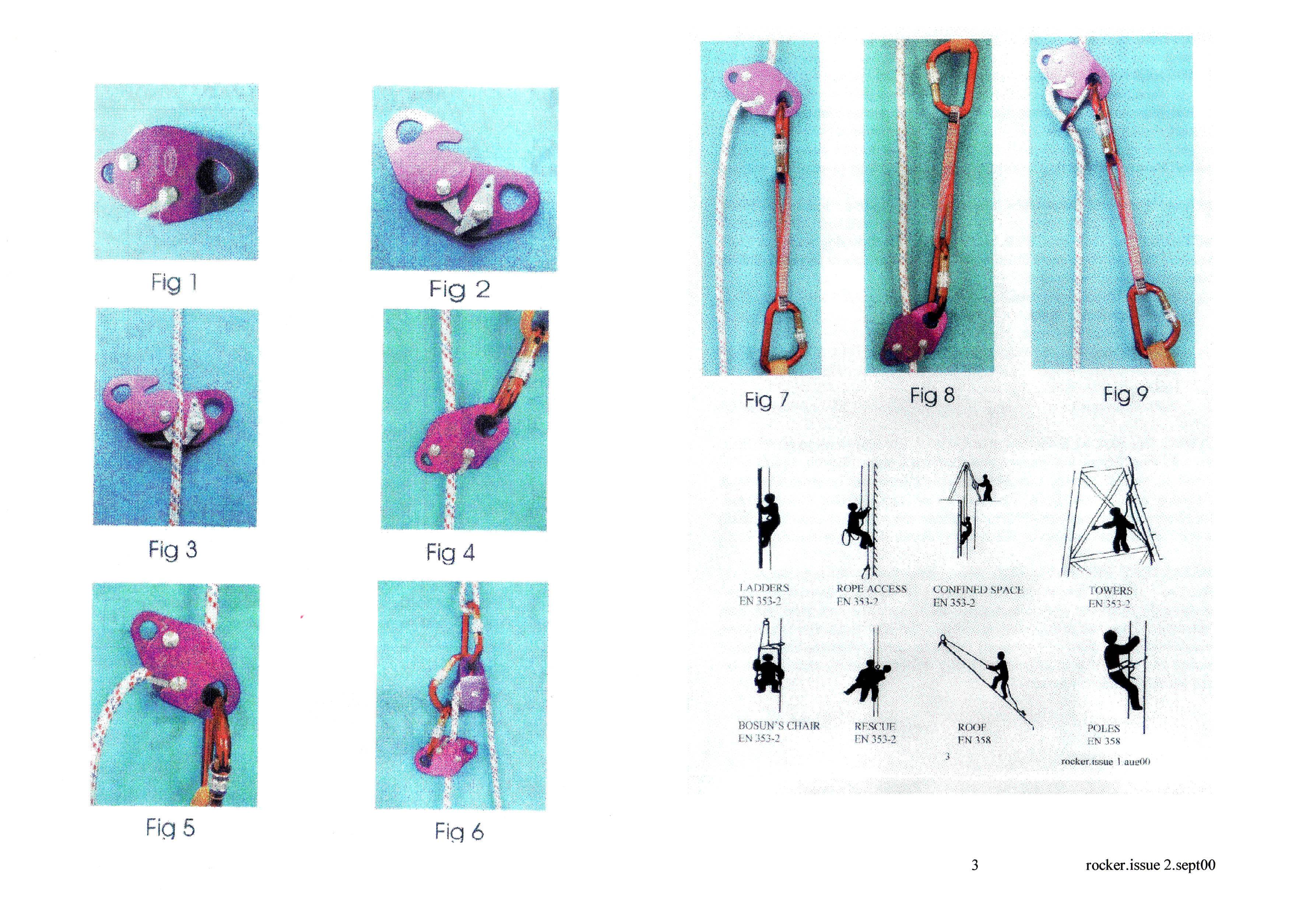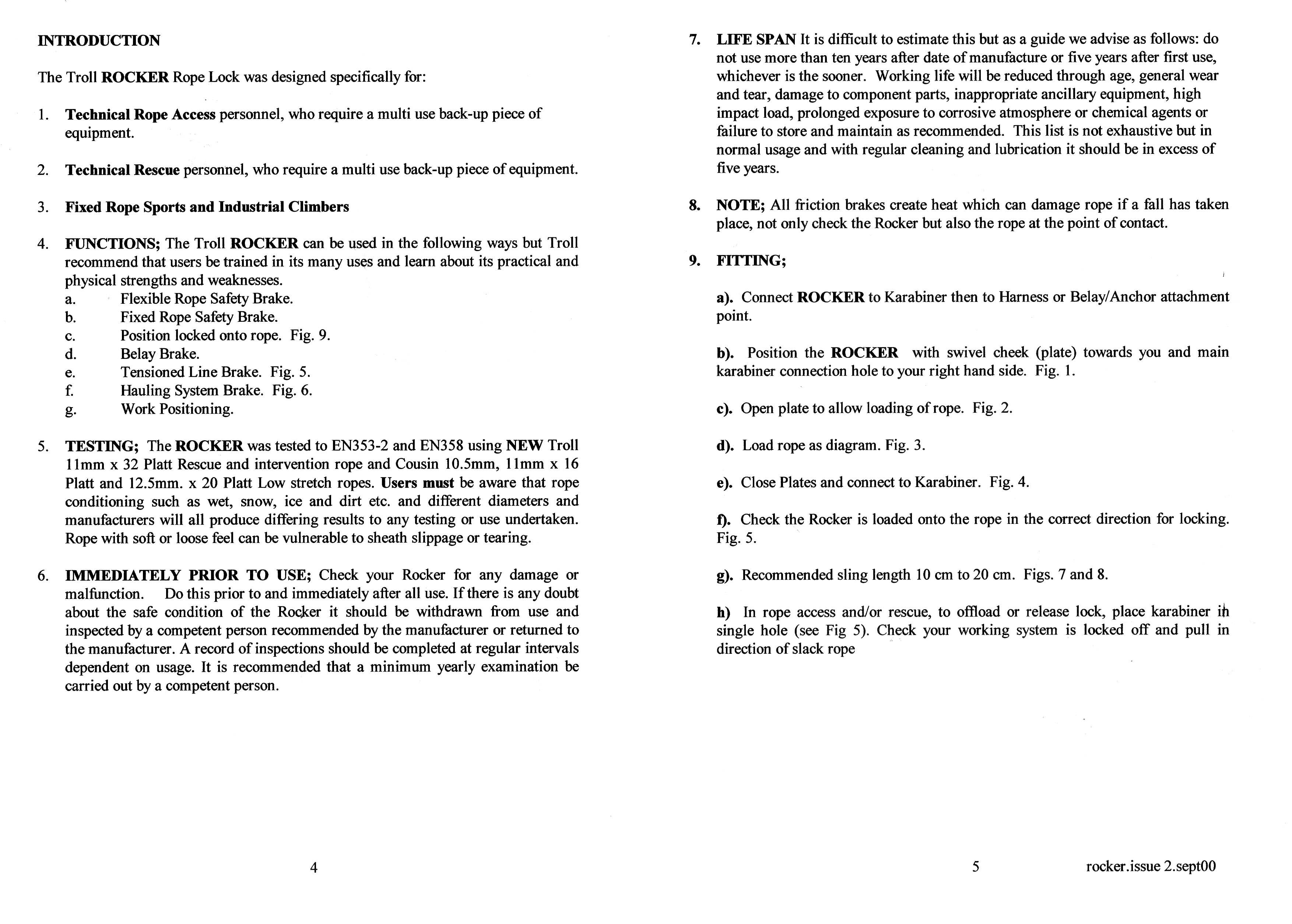Overview
[ Top
| Version B
| Return to Rope Grabs ]
Version A
(#742)
Technical Details
I acquired my Troll Rocker from Dalloz Fall Protection in September
2001.
The Rocker consists of a movable lever and a fixed anvil sandwiched
between two plates. The rear plate is a diamond-shaped stamping
made from 4.3 mm. anodized aluminum. A round 15.0 mm. hole is cut
in the right side of the plate, and a larger 23.8 by 24.2 mm. hole is
cut in the left side. The front plate is pear-shaped and smaller,
lacking the projection for the upper hole. The front plate pivots
on the lever mounting pin, and a notch in the left side of the
front plate provides clearance for the anvil mounting pin.
The anvil and lever appear to be 14 mm. slices cut from an aluminum
extrusion and subsequently anodized. The anvil is attached to
the rear plate by a round-head stainless-steel bolt that threads
into a "nut" behind the rear plate. The "nut"
is turned to form a rounded head; it has no flat surfaces for
using a wrench. The bolt shaft is stepped, with an 8 mm. diameter
for 4.6 mm. to engage the front plate notch, then 7 mm. where it
passes through the anvil and rear plate to the "nut."
A coiled pin through the rear shell keeps the anvil from turning.
The anvil itself is shaped like a low, wide isoceles triangle,
with a cutout opposite the lever end. The lever is mounted on
a similar bolt, but is free to rotate. A small spring forces the
lever to the engaged position. A cutout on the rear side of the
lever provides clearance for the spring.
The front plate has "CE0120," "EN353-2,"
"EN358," "Rocker" and the Troll logo printed
on the face. The inside of the rear plate has the "Sieg Heil" icon stamped between the hammer
and anvil, and the serial number "00013" stamped to
the side.
The following rope grabs are all variations of the same basic design:
Each of these is a compact, lightweight (except for the stainless steel Proverti AC081) fall arrest that can also
be used as a ratchet when hauling loads over a pulley. They can all be used as rocker-arm ascenders, but that was not the original design intent for the Troll Rocker, the progenitor of the others in the chart.
These have no sharp teeth to cut the rope
sheath. Some informal testing suggests that, lacking teeth, these can slide
before engaging, but normally the slippage is less than a foot.
The cases where I observed this were somewhat contrived (i.e.,
I held the grab in a specific position and carefully dropped
the load straight down), and so I'm not too worried about the slippage. I would be far more concerned if they had sharp teeth and didn't slip at all.
The top hole is used for releasing or offloading a locked rocker by placing a carabiner in the hole and pulling toward the slack rope.
Except for the early Troll, each of these incorporates a lever lock. Troll added one to theirs before the others came out. The lever lock works, but one needs to be careful not to bump
it so that it accidentally disengages. A carabiner in the upper
hole can help prevent this. When the lever lock is disengaged,
it blocks access to the upper hole.
The NTR, Vertical, and Z&W have a forward 90° bend at the top of their lever lock, making their locks much easier to operate than the others that rely on shallow rounded serrations.
Troll warns that using a rocker as a on soft
or loose-sheathed ropes can cause the rope sheath to slip or tear. They also warn that rope conditions (water, ice, mud, dirt, etc) as well as rope diameter, manufacturer, etc. will affect device performance. These warning apply to all of these fall arrests.
[ Top
| Version A
| Return to Rope Grabs ]
Version B
(#2776)
Technical Details
I acquired my Troll Rocker from Adventure Outdoors in 2019.
The Rocker consists of a movable lever and a fixed anvil sandwiched
between two plates. The rear plate is a diamond-shaped stamping
made from 3.9 mm. anodized aluminum. A round 15.0 mm. hole is cut
in the right side of the plate, and a larger 23.8 by 24.2 mm. hole is
cut in the left side. The front plate is pear-shaped and smaller,
lacking the projection for the upper hole. The front plate pivots
on the lever mounting pin, and a notch in the left side of the
front plate provides clearance for the anvil mounting pin. A subpentagonal locking tab made from 2.9 mm. anodized aluminum alloy pivots on a rivet to the left of the top hole. This tab has eight shallow notches, creating a serrated top that povides for a betterr grip.
The anvil and lever appear to be 14 mm. slices cut from an aluminum
extrusion and subsequently anodized. The anvil is attached to
the rear plate by a round-head stainless-steel bolt that threads
into a "nut" behind the rear plate. The "nut"
is turned to form a rounded head; it has no flat surfaces for
using a wrench. The bolt shaft is stepped, with an 8 mm. diameter
for 4.6 mm. to engage the front plate notch, then 7 mm. where it
passes through the anvil and rear plate to the "nut."
A coiled pin through the rear shell keeps the anvil from turning.
The anvil itself is shaped like a low, wide isoceles triangle,
with a cutout opposite the lever end. The lever is mounted on
a similar bolt, but is free to rotate. A small spring forces the
lever to the engaged position. A cutout on the rear side of the
lever provides clearance for the spring.
The front plate has "CE0120," "EN353-2,"
"EN358," a book-with-an-"i" icon, "Rocker," the Troll logo, "•," and "Ø 10.5 - 12.7mm" printed
on the face. The rear plate has the "Sieg Heil" icon stamped on the inside between the hammer
and anvil, and "03-07723LM" stamped in dot-matrix font on the rear.
The following rope grabs are all variations of the same basic design:
Each of these is a compact, lightweight (except for the stainless steel Proverti AC081) fall arrest that can also
be used as a ratchet when hauling loads over a pulley. They can all be used as rocker-arm ascenders, but that was not the original design intent for the Troll Rocker, the progenitor of the others in the chart.
These have no sharp teeth to cut the rope
sheath. Some informal testing suggests that, lacking teeth, these can slide
before engaging, but normally the slippage is less than a foot.
The cases where I observed this were somewhat contrived (i.e.,
I held the grab in a specific position and carefully dropped
the load straight down), and so I'm not too worried about the slippage. I would be far more concerned if they had sharp teeth and didn't slip at all.
The top hole is used for releasing or offloading a locked rocker by placing a carabiner in the hole and pulling toward the slack rope.
Except for the early Troll, each of these incorporates a lever lock. Troll added one to theirs before the others came out. The lever lock works, but one needs to be careful not to bump
it so that it accidentally disengages. A carabiner in the upper
hole can help prevent this. When the lever lock is disengaged,
it blocks access to the upper hole.
The NTR, Vertical, and Z&W have a forward 90° bend at the top of their lever lock, making their locks much easier to operate than the others that rely on shallow rounded serrations.
Troll warns that using a rocker as a on soft
or loose-sheathed ropes can cause the rope sheath to slip or tear. They also warn that rope conditions (water, ice, mud, dirt, etc) as well as rope diameter, manufacturer, etc. will affect device performance. These warning apply to all of these fall arrests.
[ Top
| Version A
| Version B
]




